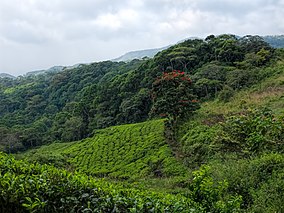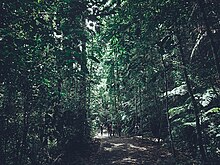This article has multiple issues. Please help improve it or discuss these issues on the talk page. (Learn how and when to remove these messages)
|
Sinharaja Forest Reserve is a forest reserve and a biodiversity hotspot in Sri Lanka. It is of international significance and has been designated a Biosphere Reserve and World Heritage Site by UNESCO.[1]
| Sinharaja Forest Reserve | |
|---|---|
 View of Sinharaja Forest Reserve with tea garden | |
 | |
| Location | Sabaragamuwa and Southern Provinces, Sri Lanka |
| Nearest city | Rakwana |
| Coordinates | 6°25′00″N 80°30′00″E / 6.41667°N 80.50000°E |
| Area | 88.64 km2 (34.22 sq mi) |
| Established | April, 1978 |
| Governing body | Department of Forest Conservation |
| Criteria | Natural: ix, x |
| Reference | 405 |
| Inscription | 1988 (12th Session) |
According to International Union for Conservation of Nature (IUCN), Sinharaja is the country's last viable area of primary tropical rainforest. Over 60% of the trees are endemic, many of them considered rare. 50% of Sri Lankan's endemics species of animals (especially butterfly, amphibians, birds, snakes and fish species)[clarification needed]. It is home to 95% endemic birds.
The hilly virgin rainforest, part of the Sri Lanka lowland rain forests ecoregion, was saved from the worst of commercial logging by its inaccessibility, and was designated a World Biosphere Reserve in 1978 and a World Heritage Site in 1988.
Because of the dense vegetation, wildlife is not as easily seen as at dry-zone national parks such as Yala. The most common larger mammal is the endemic purple-faced langur.

Birds tend to move in mixed feeding flocks, invariably led by the fearless Sri Lanka drongo and the noisy orange-billed babbler. Of Sri Lanka's 26 endemic birds, the 20 rainforest species all occur here, including the elusive red-faced malkoha, green-billed coucal and Sri Lanka blue magpie.
Reptiles include the endemic green pit viper and hump-nosed viper, and there are a large variety of amphibians, especially tree frogs. Invertebrates include the endemic Sri Lankan birdwing butterfly and leeches.
Etymology
editSurrounded in dense fog, the dark and mysterious Sinharaja forest is steeped in deep legend and mystery. The word Sinharaja means lion- (සිංහ/சிங்கம் sinha) king or kingdom (රාජ/ராஜா raja), and a popular folk legend has it that a legendary lion lived in this protected forest.
Geography
editLocation
editSinharaja Forest Reserve covers most of the Kalu Ganga basin and a small part of the northern Gin Ganga. Most of the forest (60%) is contained within the borders of Rathnapura District. The other parts include Galle District with 20% and Kaluthara District with 20%.[2]
Natural
editThe rainforest likely formed during the Jurassic period (from 200 million years to 145 million years ago). This forest encompasses an area of 36,000 hectares (88,960 acres/360 km2).[3] The reserve is only 21 km (13 mi) from east to west, and a maximum of 7 km (4.3 mi) from north to south, but it is a treasure trove of endemic species, including trees, insects, amphibians, reptiles, birds, and mammals. Sinharaja forest vegetation density has been estimated at 240,000 plants per hectare, the most dense rain forest in Asia.[4]
Human activity
editThe reserve is well-integrated with the local population who live in some dozens of villages dotted along the border. The villages are more in number along the southern border whilst the presence of some large estates along the northern border has resulted in only a few villages there. The locals collect herbal medicine, edible fruits, nuts, mushrooms, other non-timber forest products including bees honey and a sugary sap collected from a local palm species of the genus Caryota. The sap is converted into jaggery, a local brew and vinegar. Local people walk in the forest to collect the above items when they are not busy with their other agricultural pursuits. In addition, the crystal-clear water coming from dozens of streams is the main water source for all people living around the reserve. For generations, local people trekked through the forest from south to north to make their annual pilgrimage to the Adams Peak.
In 2013, UNESCO requested to halt the widening of the ancient road linking Lankagama area to Deniyaya along a 1-km jungle patch inside the protected area after a complaint from the Centre for Environmental and Nature Studies of Sri Lanka. The construction was recommenced on August 10, 2020 after prolonged appeals to the Sri Lankan government by the villagers. A group of environmentalists carried out a big social media campaign and asked the Sri Lanka Forest Department, the President, the Ministry of Environment and the Central Environment authority to stop this but the Government of Sri Lanka has decided to go ahead with it to improve the livelihood of poor villagers of the area as it will clear only 0.006% of the total landmass of the forest.
Mr. Martin Wijesinhe was one of the most significant people in Sri Lanka in connection to the Sinharaja.[5] He was the unofficial guardian of the Sinharaja. He has been the protector and caretaker of it since the 1950s till his death in 2021.[6]
- Sri Lankan elephant (Elephas maximus maximus)
- Sri Lankan leopard (Panthera pardus kotiya)
- Sri Lankan deer (Rusa unicolor unicolor)
- Sri Lankan spotted chevrotain (Moschiola meminna)
- Sri Lankan jackal (Canis aureus naria)
- Toque macaque (Macaca sinica)
- Red slender loris (Loris tardigradus)
- Purple-faced langur (Semnopithecus vetulus)
- Sinharaja shrew (Crocidura hikmiya)
- Golden palm civet (Paradoxurus zeylonensis)
- Paradoxurus aureus
- Golden dry-zone palm civet (Paradoxurus stenocephalus)
- Sri Lankan brown palm civet (Paradoxurus montanus)
- Yellow-striped chevrotain (Moschiola kathygre)
Gallery
edit-
A waterfall in Sinharaja Rainforest
-
Common Birdwing
-
Yellow-browed bulbul
-
Purple-faced langur with baby
-
A stream in the reserve
-
The high tree canopy in the reserve
See also
editNotes and references
edit- ^ "Sinharaja Forest Reserve". UNESCO World Heritage Centre. Retrieved 2020-08-17.
- ^ "Sinharaja Rain Forest Sri Lanka | Wildlife Places in Sri Lanka". www.ceylonexpeditions.com. Retrieved 2020-09-29.
- ^ "Sri Lanka's Sinharaja rainforest reserve to be quadrupled in size". Mongabay Environmental News. 2019-12-17. Retrieved 2020-09-29.
- ^ "Mahoora tented safari camps Sinharaja Rainforest". www.mahoora.lk. Retrieved 2020-09-29.
- ^ Gunatilleke, Nadira. "Unofficial 'caretaker' of Sinharaja". Daily News. Retrieved 2020-09-29.
- ^ Lokuliyana, T.P. "Unofficial caretaker of Sinharaja, Martin Wijesinghe, dies". Ceylon Today. Retrieved 2021-12-31.
- ^ "Sinharaja Rain forest | Trekking in Sinharaja Rain Forest | Sinharaja Forest Reserve, Sri Lanka". bestoflanka.com. Retrieved 2020-09-29.